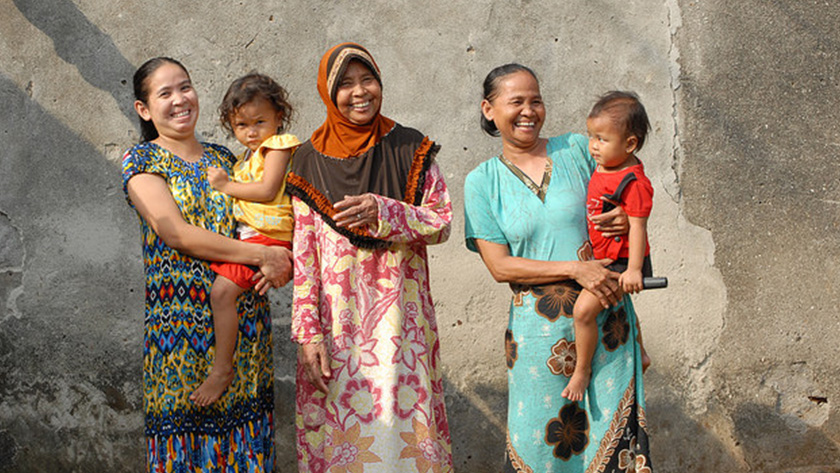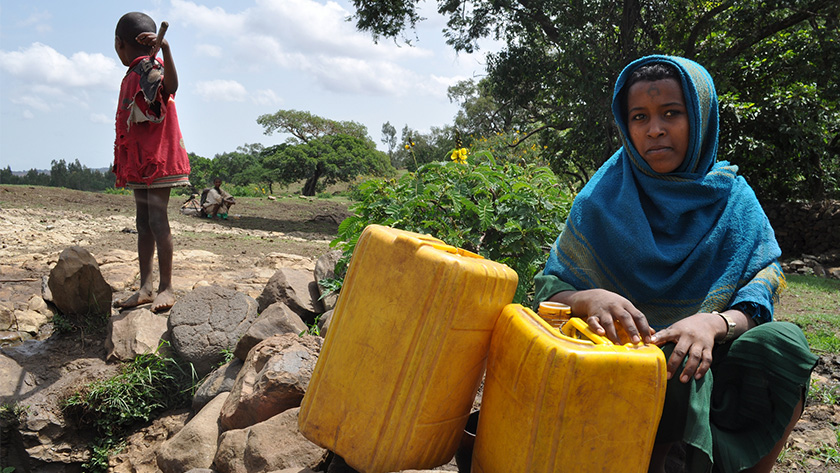Since the day COVID-19 arrived in your country, how many times have you washed your hands? It’s probably an impossible question. The 20-second interludes have become a part of life. Handwashing is the frontmost of frontline defenses against the pandemic, made possible by the systems that bring most of us safe water on tap. This life-saving action, though, is not possible for everyone, not by a long shot.
Millions of people are left behind by the seemingly simple advice to wash their hands: 785 million, globally, who lack access to safe water. Without safe water at home, basic protections become a lot less basic. Many people must leave home for hours every day and gather in crowds to collect water. Many must buy it from vendors, at prices that have spiked during the emergency and balance the cost of handwashing against drinking water and food.
Water inequalities cut through the ongoing history of this pandemic and make it a disaster for people living in poverty. Yet while we exercise the privilege of washing our hands, it’s also significant to consider the duality of our motivations. Those of us who can wash our hands do so, not only to protect ourselves, but to slow the pandemic for everyone. Acting right now as a social enterprise organization is not so different: it starts with practical concerns of protection and survival, but it doesn’t end there.

For Water.org, which works in 13 countries to help people finance and achieve their own water solutions, the operational problems were immediate. Each of those countries instituted its own lockdown, travel restrictions, and bans on gatherings. Water.org teams everywhere had to shift to remote work, shift assignments, and suspend office visits and field data collection. We rushed to develop and share videos and other resources on COVID-19 prevention. We are attending and hosting international webinars to retain a global perspective among myriad local concerns. We also experienced a significant impact on fundraising that has compelled us to make hard choices about costs.
The largest part of Water.org’s work is achieved in partnership with microfinance institutions. It’s primarily through these partners, along with community projects and utilities, that we have made it possible for 30 million people living in poverty to gain safer access to water and sanitation. And while our own teams have recovered their balance, the world of microfinance has confronted worrying disruptions. Lending totally halted in some countries, for a time, or was targeted to emergency purposes. Liquidity is at a trickle. Microfinance lenders in some markets are restructuring payments or have stopped collecting them. Similarly, most of the water utilities and service providers we work with are continuing to provide services, regardless of whether their customers can pay or governments will allow them to collect.
Because water and sanitation are the most essential of essential services, there was never any possibility of putting our mission on hold. We were all too aware of the connections between water inequalities and COVID-19 vulnerabilities; we considered them every time we washed our hands. As with the constant scrubbing, we knew that we weren’t just seeking a return to operations for our own sake, but for millions of people who were in much more vulnerable positions. We could have some impact on the inequitable course of the pandemic, too.
As the pandemic exploded, we knew we needed a systematic way of tying our actions together. It was the decisions we made early in April, through a high-level framework adopted organization-wide, that made this possible. The framework included basic concerns like staff protection, cash management, and scenario modeling. It also looked at impact from the other side: we promised to each other that we would play offense by searching for opportunities to make a difference within the COVID-19 environment. Our Global Impact department, while involved in all areas, took this proactive side of the framework, and ran with it.
We recognized that people experience the pandemic in different ways everywhere we work, and decided to base this work on insights, not just from Water.org’s leadership, country leads, or practice leads, but everybody in the organization. We gathered, and have continued to gather, monthly updates across our teams and in their conversations with partners. This generated a wealth of ideas for responding to the pandemic and its root causes.
Most importantly, because Water.org’s work is patient system change, it has been necessary to keep multiple time scales in view at once. Some actions are needed now, others later—yet the near, medium, and longer term are as fuzzy as all concepts of calendar time seem to be from within the pandemic. The timelines are uncertain; the actions are clear.

In the near term of the pandemic, every organization’s guide must be the greatest needs of its partners and the people it serves. Where our focus has been on helping microfinance institutions expand their lending for taps and toilets, we are well aware that new lending is on hold almost everywhere. Instead of growth, it’s time to talk about the resilience of our partners, micro-lenders and service providers alike. Their concerns are retaining customers, mitigating immediate financial threats, and operating through the pandemic. Among other forms of support we are rolling out an e-learning platform to take our capacity building online, which, fortuitously, we were already developing out of our global evidence base before the coronavirus arrived.
These institutions allow customers living in poverty to secure their health and enhance their resilience. Right now, customers badly need information they can trust, too, and microlenders have a direct line of communication with them. Therefore, we are directing resources to health and hygiene messaging through microlenders and service providers. And based on that experience, we are advocating as broadly as possible for a vision that links water with health. We have discovered that we are well placed in our networks of existing relationships to help national ministries and other stakeholders coalesce around a recognition of water as PPE, and of water equality as part of relief and resilience measures. These coalitions are likely to come together through virtual events and gatherings for the near future, but come together they must.
It is hard to predict very much about the medium term—what we might tentatively call 2021—but we feel confident in anticipating that the world’s focus on equitable access to water and sanitation will intensify. The demand for water solutions in homes, businesses, and public spaces will be a drive to protect more people from sickness. Already, despite a business slowdown, local utilities tell us they are eager to reach more under-served neighborhoods and under-protected neighbors. Where such motivation wells up, technical assistance becomes vital. We will put our Global Technical Assistance Facility at the disposal of lenders, service providers, and government entities. More than ever, a portion of this assistance must be in support of digital lending applications. We have already supported some microfinance institutions in digitizing their lending and repayments; during and after the pandemic, this approach has suddenly become a key tool allowing household investments to continue in a safe and socially distanced way.
Digital payments are also a tool for service providers, a set of partners that are becoming more and more important to us. We are developing a global service provider strategy in recognition of their role in overcoming water inequalities. Right now, the situation they are concerned about, and in some countries already face, is one in which they are required to deliver water and sanitation services as part of a public health emergency response while being unable to collect tariffs and fees to provide those services. We are reorienting our technical assistance around this dilemma, helping service providers manage the financial impacts of COVID-19 now and learn ways to operate in a pandemic environment.
Water.org’s longtime focus on household lending, where demand is always strong among under-served communities, is branching out to include lending for small and medium-sized enterprises that have been mandated, strongly encouraged, or simply want to provide handwashing facilities and other improvements for their customers and employees.
Moving forward like this will likely require some changes in the larger finance world to keep water solutions accessible to poor households. Larger development finance players need to forge agreements to offer concessionary and blended capital to microlenders so they can make their own terms more affordable. This will be part of an emerging strategy to prevent future pandemics and improve people’s water and sanitation access that will traverse sectors between water, health, urban development and more, and ideally connect in meaningful ways with national stimulus packages. As that strategy coalesces, the longer term will come into view.
It’s in the world after the pandemic – let’s be optimists and call it 2022 – that playing offense, adaptably and attentively, will truly drive impact. That means thinking not just about how to flatten each wave of infection, but about how COVID-19 and other, future pandemics can be answered differently.
This will from governments, the financial sector, and communities themselves must be met with accessible, sustainable answers. Service providers, coming out of the pandemic, will know the resources they have at their disposal and develop effective business models that attract financing from local institutions, international development banks, governments, or most likely some combination of the three. Cities, which now must regard themselves as potential hotspots with lightning-fast transmission and highly vulnerable populations, need urban solutions financed at the household or neighborhood level. Impact investors will continue the dialogue around preventing inequitable health threats for a long time to come. A water and sanitation bond market, still in the early stages globally, will grow and align itself readily with green and climate bond financing principles.
COVID-19 has changed a lot of things. In other ways, not much has changed. In 2019, about a million people died from diseases like typhoid and diarrhea that could also have been prevented with access to safe water and sanitation. The same thing happened the year before that, and the year before that. The novel coronavirus is just one more threat to people living on the wrong side of water inequalities, and it won’t be the last. The world must see safe water and sanitation as essential elements of resilience for the future—and now we are. That’s what has really changed.
With this perspective, governments will prioritize safe water and sanitation in every health emergency response. Donors and impact investors will fund resilience in addition to relief, and target water inequalities to make a lasting difference. Financial institutions will see that lending for water and sanitation generates financial security and changes lives. And the next novel virus will emerge into a world that has the universal systems, institutions, and commitment to break the chain of pandemic before it starts.
About Water.org
Water.org is an international nonprofit organization that has positively transformed more than 30 million lives around the world with access to safe water and sanitation. Founded by Gary White and Matt Damon, Water.org pioneers market-driven financial solutions to the global water crisis. For more than 25 years, we’ve been providing women hope, children health, and families a future.
The most powerful action you can take right now to help build resilience and hope for families living in poverty is to invest in the Water.org COVID-19 Resilience Fund.